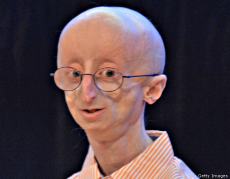

Progeria is the syndrome where symptoms suggest a premature age, such as Hutchinson-Gilford progeria syndrome, Werner syndrome and Down’s syndrome.
Hutchinson-Gilford progeria syndrome affects 1 in 4-8 million people. The syndrome is not normally passed on as sufferers normally die before hitting puberty. It is highly noticeable, as despite features being similar to old age, there are characteristics which are either abnormal or show that they are in fact rather young. Sufferers can experience: a disproportionate head size, early loss of hair, slow growth, a small face, a pinched nose, hardened and tight skin, a senile appearance, fragile bodies, absence of fat, painful joints and can have coronary artery disease. Coronary artery disease is the usual cause of death. Their expected lifespan is between 7 and 30 years. The syndrome is caused by a mutation in chromosome 1q (the long q arm of chromosome 1). The mutation occurs in the LMNA gene that encodes lamin A protein. Mutations vary; most being a substitution on codon 608 in exon 11. Some cases have been on exon 2). Mutations have led to deleted amino acids near the end of a sequence (the c terminus).
Lamin A is part of cytoskeleton (an intermediate filament), it promotes genetic stability through the maintenance of proteins levels, these proteins have key roles in DNA double strand break repair. Thus, with a defective protein comes inefficient DNA repair. Although symptoms of Hutchinson-Gilford progeria syndrome to resemble that of ageing, sufferers do not face other factors associated with ageing. For example, there is no increased risk of cancer, males do not have prostate problems, high blood pressure is rare and sufferers do not get Alzheimer’s.
Werner syndrome is a syndrome that is not physically evident from birth. Individuals with the syndrome will develop normally into teenagers until they hit puberty. After hitting puberty, symptoms start to show rapidly. It’s as if they rapidly age in the space of a few years. They experience hard and thin skin, thin grey hair, a hoarse face, and abnormal fat deposition. Like Hutchinson-Gilford progeria syndrome, it is noticeable that individuals are not elderly. Werner syndrome affects 1 in 1 million people and oddly, 1 in 20,000-40,000 Japanese people. As the syndrome develops, sufferers experience cataracts in both eyes, skin ulcers, osteoporosis, cancer, atherosclerosis, type 2 diabetes and diminished fertility. The common cause of death is cancer and atherosclerosis.
Normal fibroblast cells double 60 times in tissue culture whilst Werner cells only double 20 times. The syndrome is caused by a mutation in the WRN gene, which encodes a DNA helicase. DNA helicases participate in transcription. Transcription is the process by which information in a strand of DNA is copied into a new molecule of messenger RNA. This messenger RNA is then used for the production of new cells. The mutation in the WRN gene causes faulty DNA replication at the telomeres, leading to overexpression in vitro (in practical experiments) of telomerase counteracts mutation suggesting that wild type has a role in efficient replication of telomeres, preventing genomic instability. However, those with the syndrome do not experience prostate problems, there is no high blood pressure and they do not get Alzheimer’s.
image- https://www.newsmax.com/thewire/sam-berns-progeria-aging-disease/2014/01/13/id/546793/

0 Comment:
Be the first one to comment on this article.